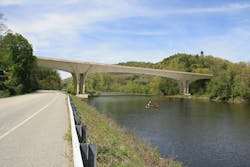No. 1 - I-91 Brattleboro Bridge
When putting together a complicated 3-D puzzle, you really cannot build around a missing piece.
As FIGG and PCL Civil Constructors were attempting to mold together the first pier table of the I-91 Brattleboro Bridge in Vermont in late October, extreme measures were being taken to make sure there was not a void in the process.
“As you extend up from those piers that are curving in two different directions at the same time, we are putting [what amounts to] a three-story building of concrete right on top of those four piers,” Garrett Hoffman, project manager for FIGG, told Roads & Bridges, “so having the diaphragms to distribute that load from the bridge down into the piers like that, it’s requiring a lot of steel and that complexity is taking a while to complete.
“There’s a lot of reinforcement and a lot of congestion, and it becomes a very big 3-D puzzle.”
Those double-acting piers Hoffman referred to are the centerpiece of a whole gallery of engineering innovation, which made the I-91 Brattleboro Bridge the obvious choice for No. 1 on this year’s Roads & Bridges’ Top 10 Bridges list. It’s actually called a quad wall pier system. An opening sits between two walls so that there are actually four legs of the column, which is supposed to have the look of a giant tree.
In late October, construction of pier No. 1 on the south side of the West River was complete, ushering in the complex handling of the diaphragm and its 300-yd concrete pour, and crews were already on lift two (which is about 70 ft off the ground) of pier No. 2 on the north end. The goal: to have the pier table on No. 1 complete by Christmas, so form travelers could be installed and the first segment could be cast before cold weather settled in.
“They want to get one segment done and a cycle behind them before the hard winter sets in, so they are not dealing with learning a cycle time for a segment as well as dealing with the hardships of winter,” said Hoffman.
After last winter it’s no wonder tensions were running high heading into November. During the polar vortex of 2014, Mother Nature gave Vermont a reprieve in January with a couple days of mild winter. The spike in temperature, however, unleashed a huge rush of water that was plugged farther upstream, and when frigid conditions returned the next day PCL Civil Constructors found its equipment literally frozen in the West River.
Hoffman said they are now out of that danger zone because no machines are in the water, but winter will still be a challenge due to the amount of concrete curing that is set to take place. Additional insulation in the form of tenting, burlap and blankets will be used to create an ideal environment for strengthening the concrete—which comes in three different forms. The footings of the bridge required a 700-yd mass concrete pour—the largest in the state of Vermont. Self-consolidated concrete is being used to construct the piers, and an 8,000-psi high-performance concrete will be used for the bridge deck.
FIGG and PCL Civil Constructors wanted to blend the bridge in with the Vermont wilderness as much as possible. To help make the piers look like trees, a Bella Vernici eco-stain will be used. The columns also will have a natural stone look. FIGG and PCL Civil Constructors initially wanted to use real stone, but after Vermont rejected the request due to cost, it was decided to use form liners, which had an average relief of 4.5 in. The belly of the concrete bridge deck will have an arch shape to it and will be painted the color of the sky, so kayakers traveling the West River will be able to take an aesthetically pleasing—albeit brief—paddle break when they travel underneath the I-91 Bridge. Observational decks and kayak launching areas also will be constructed by both of the piers; moreover, before construction started FIGG and PCL Civil Constructors relocated a hiking trail on the north end in an effort to keep the locals happy.
Mock tests were being conducted for the inverted portion of the deck in late October, and all indications were that it was going to be a tricky concrete pour.
“It’s not a normal concrete pour,” said Hoffman. “What gets tricky are those slope issues up top . . . how we form that off and making sure we are able to pour the concrete and get good consolidation, and at the same time have some sloping at the top part of it. How much will they be able to do by hand? That’s what we need to figure out with the mock test.”
When complete in 2016, the new I-91 Brattleboro Bridge, which is replacing structurally deficient and functionally obsolete twin steel truss bridges, will carry four lanes of traffic, but will have the capacity of as many as eight lanes. The design will give maintenance crews the ability to shut down lanes for future work without impacting the commute. R&B
